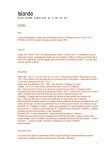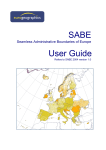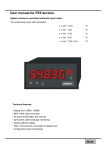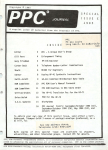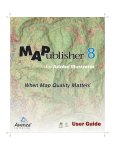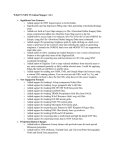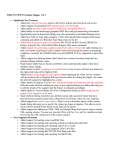Download Manual - Cocodati
Transcript
cocodati hide Coordinate Conversion and Datum Transformation in Iceland Version 1.3 Online Software - Manual and Technical Reference May 1st, 2004 Version 1.3 of cocodati was thoroughly tested and appeared to work flawlessly. However, as any new release, it is expected to reveal inconveniences, obstacles and/or even malfunction in everyday use. Users are encouraged to hand in suggestions and report encountered bugs. Thank you in advance, Markus Rennen Markus Rennen May 1st, 2004 2 1. General Product Information The online tool cocodati has been developed, in its entirety, at Landmælingar Íslands (LMÍ)1. Program author Dalia Prizginiene ([email protected]); supervision Markus Rennen ([email protected]). The mathematics is taken from the sources reported at the end of this manual (see References); the online tool itself was created using HTML, Java Script and Java. 2. About this Manual This manual is supposed to guide the user through the operation of cocodati. It does NOT intend to contain all necessary information regarding coordinates, coordinate formats, geodetic datum definitions, projections etc. For general information the user is referred to the geodetic literature, for specifics of Icelandic definitions, it is recommended to refer to RENNEN M. “Basics on Coordinates and their Reference” (available on the LMÍ homepage http://www.lmi.is/landmaelingar.nsf/HtmlPages/Coordinates-inIceland/$file/Coordinates-in-Iceland.pdf). 3. Legal Remark Although thoroughly tested, any software might present errors, bugs and/or malfunctions. The National Land Survey of Iceland (LMÍ) cannot be held responsible for complications caused by software errors, faulty use or misinterpretation, temporary unavailability of the online application etc. and any emerging implications. The same applies for the contents of this manual. 1 Except NKG Geoid and subroutine for Geoid height interpolation by René Forsberg, KMS, courtesy of Kort&Matrikelstyrelsen (National Land Survey of Denmark) Markus Rennen May 1st, 2004 3 4. Practical remark for Iceland A common but nevertheless serious misunderstanding in Iceland is to refer to coordinates given in Latitude φ,Longitude λ and height as WGS84 while coordinates in East, North and height are labeled as ISN93. This is simply wrong!!! WGS84 and ISN93 are different datum definitions and due to tectonic plate motion currently showing a difference of a few decimeters, or with other words coordinates given in one of these datum definitions need to be shifted a few decimeters to fit into the other. However, and that is the misunderstanding, it is not this difference the users are usually trying to correct between WGS84 and ISN93”, in general they need to change format from φ, λ and height towards East, North and height within the ISN93. This change does NOT change the datum definition, does NOT require transformation parameters and can therefore be performed without loss of quality. In order to perform this operation (φ, λ and height → East, North and height) in cocodati the ISN93 datum has to be chosen on both sides, i.e. the input side on the left and the output side on the right!!! Further information for program operation see below. A misunderstanding, going along with the above mentioned, is the presumed “scale of the ISN93”. The ISN93 does not have a scale! The apparent scale detected between true distances and coordinate derived distances alongside practical surveys, is not caused by the ISN93 but by the frequently associated Lambert Conformal Conic projection. ISN93 coordinates in geocentric cartesian X,Y,Z format do not show any scale except random errors. Scale is simply a problem of the chosen projection. When using projected coordinates for practical purposes (e.g. construction) small scale surveys (<1km) can be corrected by applying the local scale (provided by cocodati). In larger areas (especially North/South extension for Lambert coordinates resp. East/West extension for UTM coordinates) the scale is changing significantly for projected coordinates. It is rather difficult to handle this change in practice. Thus it is strongly recommended not to use projected coordinates for extended surveys. Calculations can be carried out in non-scaled coordinate formats (such as cartesian). If complex software is used, it is strongly recommended to make sure that this software takes into account the scale corrections! Markus Rennen May 1st, 2004 4 5. Introduction With developing a tool for Coordinate Conversion and Datum Transformation in Iceland, abbreviated cocodati, LMÍ intends to enhance its public user service. So far every request regarding conversion and transformation of coordinates had to be handled individually, leading to unavoidable delays etc. The increasing number of requests at LMÍ caused increasing costs and bound recourses and hence let it appear mandatory to provide a service that enables every coordinate user to perform the required steps himself. The format as online application was chosen in to limit LMÍ’s efforts on software maintenance, shorten the update cycle and ensure that each user always works with the most recent version. For practical reasons,i.e. in order to prevent the user from false data entry, the performance of cocodati is currently limited to Iceland and its maritime surroundings (covering rather tolerant dimensions). The mathematics applied are generally strict though and provide spatially unlimited application, i.e. in extend and location. Future versions therefore might feature global coverage. 6. Features of cocodati cocodati provides a) conversion between different coordinate formats and/or projections, i.e. • Geocentric cartesian X, Y, Z coordinates (metric) • Geographic surface coordinates φ, λ and height (Latitude, Longitude and height) with optional input and output formats • ddd.ddddd • ddd mm ss.s • ddd mm.mmm • and conversion between these formats • Lambert Conformal Conic projected coordinates E, N and height (metric East or West, North and height) • Universal Transverse Mercator projected (UTM) coordinates E, N and height (metric East, North and height) Coordinate conversions in cocodati are always strict and apply rigid formulas, series expansion and/or iterative algorithms that provide sufficient depth for all spatial extends and thus do not alter the accuracy of the user’s genuine input coordinates. When choosing a particular coordinate format, either on the input or the output side, certain default values are preset (e.g. projection parameters). cocodati offers the option of any parameter to be customized manually; changes are recommended only to expert users though. b) transformation between default or user defined geodetic datum definitions • ISN93, represented by the most recent Icelandic reference network and current official geodetic datum in Iceland • Hjörsey55; ISN93’s predecessor, applied for geodetic, i.e. surveying purposes until 1993, still occasionally found as horizontal map datum or geodetic datum of historic surveys Markus Rennen May 1st, 2004 5 • • Reykjavík 1900; Iceland’s oldest nationwide coordinate reference, still occasionally found as horizontal map datum or geodetic datum of historic surveys Any kind of global or local geodetic datum with user defined transformation parameters (and if required spheroid parameters) cocodati performs a 7-parameter affine transformation in the cartesian coordinate space (i.e. all coordinate formats are first converted to 3D cartesian coordinates, then transformed and subsequently converted into the desired format). Any kind of lower order transformation (e.g. 3-parameter) can be obtained by setting the parameters to be neglected to zero. Unlike coordinate conversions (see above) a transformation is based on empirical (i.e. somehow surveyed) transformation parameters. Thus the performance of the transformation is limited by the quality of the parameters and hence can degrade the quality of the transformed coordinates compared to the original input values. If coordinate conversion and datum transformation are performed at the same time, as possible with cocodati, the quality of the obtained coordinates is predefined by the transformation parameters applied and NOT by the simultaneous format conversion or projection. Determination of transformation parameters between two user data sets is not yet a feature of cocodati, but is planned for future versions. c) 1D vertical datum transformation (linear shift) from ellipsoidal heights “h” to Mean Sea Level heights “H a.MSL” and vice versa. The operation is performed at the end of the internal workflow using the NKG96 Geoid (supplemented by an Iceland specific linear offset, calculated at LMÍ). d) On-screen input of individual point coordinates and corresponding on-screen output or file input with corresponding file output e) Online assistance (Help) 7. Help Figure 1: Help access The online help, or rather online assistance, provided by cocodati was designed to support users with answers to simple questions e.g. entry formats; for detailed information refer to this manual or the recommended literature. Instructions for online assistance access can be found on the top-right of the input screen (Figure 1). Online assistance is available only for active fields (i.e. highlighted white). The online assistance appears in pop-up windows. In order to open the online assistance, the field has to be marked by placing the cursor (by mouse-click) in the desired field; with the blinking cursor inside the field the assistance appears after right-mouse-click inside the active field. The top right of the input screen also features a link to download this user manual as pdf-document. Markus Rennen May 1st, 2004 6 8. Structure of cocodati 8.1. Input and Output When opening cocodati with a standard browser, the input-screen appears (see Figure 3). Entries or changes can only be made in the input screen. Active entry fields or switches are highlighted white (Figure 2, left), while non-active fields or switches appear grey (Figure 2, right) and do not allow any entries. Figure 2: Switches Figure 3: Input screen Figure 4: Output Screen Active switches can be set “on” or “off “ by mouse-click; a switch set to “on” is indicated by a dark dot (Figure 2, left). After all entries are completed and the required switches are set accordingly, the software operation is carried out by mouse-click on the “Transform” button on the bottom center of the input screen (Figure 5). Figure 5: Transform Button After data processing the output screen appears (Figure 4), or in case of false entries an error message in a pop-up window. Within the output screen calculated values appear blue while predefined values remain in black letters. Figure 6 : New-Transformation button Markus Rennen May 1st, 2004 Figure 7: Browser "back"-button 7 The output screen is entirely non-active2 and merely designed for display. In order to return to the input screen for changes or new operations the “New Transformation” button on the bottom of the output screen (Figure 6)will return the user to the input screen or the “Back”-button of the browser can be use (Figure 7); the input screen appears again and new operations can be conducted or prior operations renewed. 8.2. Screen Structure Both cocodati screens and with them the operation structure is separated horizontally in two blocks and vertically in three blocks. The two horizontal blocks separate the area for input settings and entries on the left and the area for the output settings and results on the right (Figure 8). Figure 8: Input Settings vs. Output Settings The vertical separation (8.3 to 8.5) refers to the requirements of user definitions (see Figure 9). 8.3. “Coordinate Settings” Section The top section is dedicated to more or less formal definitions of input and output coordinates, such as data source etc. 8.4. “Datum Definition” Section The middle section is dedicated to all parameters referring the datum definition (NOT to be confused with projection). The datum choice is always to be set first3. With chosing the user datum the most commonly associated coordinate format will be set as default in the Projection/Format section. These parameters can then be changed subsequently. Coordinates showing identical formats (i.e. for instance φ, λ and height) might still be 2 3 except the “New Transformation” and the “Open”-button for file export (9.3) Eception: When using file-input, the file shall be chosen first, then the datum and so on. Markus Rennen May 1st, 2004 8 referenced to different datum definitions and vice versa coordinates of the same datum might be displayed in different formats (e.g. φ, λ and height vs. metric East, North and height both ISN93). Thus datum definition (middle section) and projection parameters (bottom section) have to be dealt with separately. The middle section also contains the parameters for a 7-parameter datum transformation. For three predefined datum definitions default transformation parameters are preset. Spheroid parameters commonly associated with the chosen datum definition are set default4. A mouse click on the “Change” button, beside the “Datum Definition” drop-down list, activates the fields for customized user entries. This option is generally meant for user defined datum definitions. Customizing parameters is strongly recommended to expert users only! Note: Changes might not only affect absolute coordinates but also relative coordinates e.g. distances! Figure 9: Logical separation of settings 8.5. “Format/Projection Parameter” Section The lower section is dedicated the fundamental coordinate format. The available choices contain two unprojected formats (cartesian and geographic) and two projected (UTM and Lambert Conformal Conic) coordinate formats. The choice of coordinate format in this section determines the units expected as input resp. being returned as output in the upper “Coordinate Settings”-section. In case of unprojected formats are being chosen, the parameters below are without significance and therefore deactivated. When one of the two projected coordinate formats is chosen, projection parameters appear in the fields of this section. The default values represent the parameters commonly associated with the chosen projection in Iceland. 4 International 1924 is identical to Hayford 1909 and GRS80 equals for all practical purposes the WGS84 ellipsoid Markus Rennen May 1st, 2004 9 A mouse click on the “Change” button, beside the “Projection/Format” drop-down list, activates the fields for customized user entries. This option is generally meant for user defined projections. Customizing parameters is strongly recommended to expert users only! Note: Changes might not only affect absolute coordinates but also relative coordinates e.g. distances! 9. Coordinate input cocodati is designed for single point input (9.1) as well as import (and export) of ASCII-files (9.2). 9.1. Single-Point Input Single-point input is understood as on-screen entries; an input file might also contain only one point (see ASCII-File import). Single-point input is the default mode and active when cocodati is launched. In order to select single-point input after ASCII-file import has been used before, the switch in front the single-point input line has to be activated (Figure 10). Figure 10: Single-Point Input Single-point input returns a single-point output in the output area on the right. It is not possible to direct the output into a file from single-point input (use ASCII-file import in order to generate an output-file). 9.1.1. Input Format and Settings The appearance of the “Coordinate Settings” entry fields changes according to the coordinate format chosen in the “Format/Projection Parameters” section. a. When choosing cartesian Geocentric (X,Y,Z; unprojected) coordinates three entry fields titled X, Y and Z (i.e. metric geocentric earth-fixed/earth-centered coordinates) appear. b. When choosing Geographic (φ, λ, h or H; unprojected) the input line shows four fields: Latitude, Longitude, h and H.a.MSL. The entries accepted are Latitude in degrees between 60°N and 70°N, Longitude in degrees between 0° and -90°. For the users upmost convenience and in order to avoid confusion cocodati will switch positive longitude values automatically to negative (i.e. 21°-West to -21°-East); this apllies as well to file-input. Markus Rennen May 1st, 2004 10 c. The following entry formats for Latitude or Longitude are accepted and recognized automatically (example for Latitude): • 64 9 11.1 (degrees minutes decimal-seconds, ddd mm ss.s) • 64 9.185 (degrees decimal-minutes, ddd mm.mmm) • 64.15308 (decimal-degrees, ddd.ddddd) Degrees, Minutes and seconds are separated by a blank (“white space”). Geographic longitude values usually refer to the zero-meridian at Greenwich. However, coordinates referenced to the Reykjavík1900 datum are often referenced to the zero-meridian defined at the Copenhagen Observatory. Note: For Reykjavík1900 geographic coordinates “West of Copenhagen Observatory” is default. Be aware of the origin of your coordinates! A switch that enables to choose the suitable zero-meridian is active when the Reykjavík 1900 datum is chosen in the “Datum Definition” section (Figure 11). The output will always refer to the Greenwich zero-meridian. Figure 11: Greenwich vs. Kopenhagen Zero-Meridian Geographic coordinates are curvilinear surface coordinates and require the definition of a spheroid in the “Datum Definition”-section. Unlike geocentric coordinates they also feature a height. The reference surface of this height needs to be known and defined when transforming coordinates (i.e. ellipsoidal or MSL-heights). d. cocodati offers the user to enter heights as ellipsoidal heights “h” or physical heights, referenced to Mean Sea Level (MSL) “H a.MSL”; only one of the height fields, “h” or “H a.MSL” alternatively, should contain an entry, the other one is to leave blank. If both fields contain entries only “h” will be processed by cocodati. cocodati can be used to transform “h” to “H a.MSL” or vice versa. In the internal workflow the geoid height interpolation and application to the input height is carried out as final step. The geoid used for Icelandic is the Nordic Geodetic Commission’s NKG96. In order to eliminate long period polynomial effects an Iceland-specific linear shift is applied subsequently. e. When choosing one of the projected coordinate formats “Universal Transverse Mercator (UTM)” or “Lambert Conformal Conic” the coordinate fields to “E, N, h and H.a.MSL” appear, i.e. metric East, North and height values. The definition and handling of the height values is analog to the description above. Though not characteristic for any particular datum, specific projections are associated with specific datum definitions. In general that is: → Lambert Conformal Conic (two parallels)5 • ISN93 • Hjörsey55 → Lambert Conformal Conic (one parallel) • Reykjavík1900 → Lambert Conformal Conic (one parallel) 5 parallel(s) refers to the number of Standard Parallels (for details refer to the recommended literature) Markus Rennen May 1st, 2004 11 The default projection parameters are preset in cocodati (Table 1). Be aware that • though the projection common for Hjörsey55 and Reykjavík1900 both feature one standard parallel, the projection parameters (central meridian, false easting, and false northing) differ. • variations in spheroid parameters do have impact on the result The default parameters of projections used in Iceland are displayed in Table 1. Table 1: Default Projection Parameters used in Iceland Central Meridian Lambert Conformal Conic Reykjavík1900 Lambert Conformal Conic Hjörsey55 Lambert Conformal Conic ISN93 Universal Transverse Mercator (UTM) Latitude of Grid Origin False Easting +6 False Northing +4 Standard Parallel 1 19°01’19.65 ” 65°00’00” 0m + West 0m + North 65°00’00” -18°00’00” 65°00’00” 500000m + West 500000m + North 65°00’00” -19°00’00” 65°00’00” 500000m + East 500000m + North 64°15’00” -27°00’00” -21°00’00” -15°00’00” 0°00’00” (Equator) 500000m + East 0m + North Standard Parallel 2 Zone 65°45’00” 26 or 27 or 28 f. Metric UTM coordinates are hardly in use in Iceland anymore (though some map corpuses projected in UTM are still in use, e.g. C762 or C761). In order to calculate with metric UTM coordinates the correct zone has to be chosen by the user in the “Format/Projection Parameter” section. Iceland is covered by three UTM zones (see Table 1). cocodati allows the transformation from one UTM zone into the neighboring zone if the coordinates are located within a 0.5° overlapping area; for coordinates outside an error message will appear. g. When using projected plane coordinates, distances are obtained scaled. The scale varies with chosen map projection and location. cocodati displays the local scale introduced to by the map projection in the “Format/Projection Parameter” Section. Thus, in order to obtain true distances, the calculated (projected) distance has to be multiplied with the inverse scale true distcance = calculated distance ⋅ 1 scale Note: Since the change of scale is a function of location, direction and map projection the application of a constant scale is only tolerable for limited areas or distances. The gradient of scale changes with location and direction and thus indicatory value can be given; as rule of thumb a constant scale is not suitable when the area of interest extends more than a few kilometers! 9.1.2. Output Format Before the conversion and/or transformation is conducted (i.e. before the “Transformation” button is pressed) the desired output datum and projection/format has to be chosen. The settings are equivalent to the input settings (see 9.1.1). 6 Positive Counting direction; coordinate values grow in direction given in the table (e.g. “+ East” indicates that coordinates grow eastwards) Markus Rennen May 1st, 2004 12 Output coordinates’ Geographic longitude values are always referred to the Greenwich Zero Meridian (even if the input of Reykjavík 1900 coordinates referred to the Copenhagen Zero Meridian). For geographic output coordinates, the desired Latitude or Longitude format (ddd mm ss.s, ddd mm.mmm or ddd.ddddd) can be chosen by setting the switch below the coordinate (Figure 2). The East-value of Lambert projected output coordinates is always displayed as genuinely defined for the associated datum. With other words the positive counting direction corresponds to the historic records. In detail that is as displayed in Table 1. For change of counting direction according to user software requirements see 9.3. North values in any case grow northwards (Table 1). 9.2. ASCII-File Import cocodati allows the import and export of ASCII text files. Figure 12: File-Input In order to indicate that file-input is desired the switch in front of the file input line must be market as shown in Figure 12. Pressing the “Browse” button will open a standard window that enables to select a file from the user’s local computer. An input file contains of at least one line and three coordinate components sorted in columns, separated by a TAB-delimiter7. Optionally cocodati also accepts coordinate files with the first column containing the point number (Figure 13). As point numbers all kinds of numeric, alphanumeric or combined strings of (in principle) infinite length are allowed, except, the point number/name must not contain a blank (“white space”)8. cocodati recognizes automatically whether the file contains point numbers/names in the first column. It is mandatory that all columns contain an entry; e.g. if the “height”-column does not contain any entry the first column (containing the point number/name) will be interpreted as first coordinate component and most probably cocodati will return an error message or entirely wrong coordinates. Figure 13 : ASCII File Format Figure 13 shows a typical ASCII input file. Column one contains the point number/name while the next columns contain the coordinate components. In the displayed 7 TAB-delimiter was chosen since software packages such as Microsoft-Excel can easily export and import files with columns separated by TAB. 8 As remedy the blank should be repalced by any other ASCII symbol, e.g. an underline as in “YTRI_STRAKUR” Markus Rennen May 1st, 2004 13 case the Latitude and Longitude values are given in “ddd mm ss.s”- format and therefore occupy each wise three columns, separated by a TAB-delimiter. cocodati recognizes automatically whether the input format of geographic coordinates is ddd mm ss.s, ddd mm.mmm or ddd.ddddd. It is mandatory that Latitude and Longitude values have the same format. Decimal separator is a “.” (lower dot). The order of coordinate components is equivalent to the single point input. For geocentric cartesian coordinates that is X,Y,Z; for geographic coordinates Latitude, Longitude, height; for all projected coordinates it is East, North, and height. cocodati allows the input file to contain comment lines e.g. a header. A line is considered as comment lines and therefore ignored if it is preceded by a “%” (see Figure 13). The comment line is not conveyed to the output file. As for single point input the ASCII file import requires the definition of datum and projection/format on the input side as well as on the output side. Additional to the user definitions required in single point the user has to define whether the heights in the file refer to “h” or “H a.MSL” (see 9.1.1) by selecting the switch beside the file entry field (Figure 12). Equivalent to single point input the desired height reference has to by chosen on the output side as well. As shown in Table 1 the projected coordinates feature historically constituted positive counting directions that differ in East/West. Especially with Hjörsey55 Lambert projected coordinates that frequently leads to confusion, for most GIS software packages (e.g. ArcInfo) do not accept westward positive counting directions. In many cases the correct false easting of 500000m is thus often substituted by the (formally wrong) false easting value of -500000m (i.e. negative East values). cocodati recognizes the automatically whether positive or negative East values are imported and handles them accordingly. For output see 9.3 below. 9.3. ASCII-File Output When the input file and the datum and projection/format settings are chosen the transformation/conversion is performed by pressing the “Transform”-button. The processing might take a while, depending on file size, i.e. the number of points. Progress is indicated by the Browser’s standard progress bar. After processing the input screen switches to the output screen and the formerly inactive “Open”-Button on the right of the output-file field is activated (Figure 14). Figure 14 : Output screen in file-input-mode In order to regard for the users’ security, it is not possible to save the output file directly to users’ local computer. Instead the output file is created on the LMÍ server under a temporary file name, displayed in the output-file field. Markus Rennen May 1st, 2004 14 A mouse click on the “Open”-Button will display an HTML page with the obtained file contents. In case non-valid entries9 have been processed the concerned line will return a “NaN” (not a number) value. For valid values the transformation/conversion will return a list of coordinates, preceded by a header that contains all definitions (Figure 15). The coordinate columns are separated by a TAB-delimiter. If the resulting output is unsatisfying, pressing the Browser’s “Back”-button (Figure 7) will return first to the output screen, another “back” will return to the input screen and enable the user to change settings accordingly. Figure 15 : Output-file format If the result is considered satisfying, the displayed file can be saved by “File” “Save as” in the Browser’s main menu. A pop-up window will be displayed and the local path can be chosen. The temporary file name can be overwritten; standard output is an ASCII text file. Note: In HTML Icelandic letters (accepted in point number/name) might not be displayed correctly. The stored ASCII file will contain Icelandic letters. In case the user does not expect difficulties, the file can also be locally stored without viewing by a right-click on the “Open”-button. Within the pop-up window chose “Save target as” and proceed as common. If Hjörsey55 Lambert projected output is chosen, a switch appears underneath the output file field (Figure 16), that allows altering between negative or positive East values as output format, according to the user’s software requirements. If marked cocodati will return negative Lambert projected East-values. Figure 16 : Choice of output format for Lambert projected Hjörsey55 coordinates © Since a number of software packages, e.g. ArcInfo , cannot handle westward positive counting directions (as historically defined for Hjörsey55 or Reykjavík 1900) these tools (incorrectly) change the false easting to -500000m and in doing so alter the direction of growing East-values. cocodati has a feature that allows the user to choose whether input or output East-coordinates are provided or shall be obtained with negative index. This feature is supposed to make further editing obsolete, especially when working with ASCII-file import. However, the user should be confident in knowing what type of coordinate format his/her software requires and how it is handling it. 9 e.g. file does not contain the format defined in the projection/format section, coordinates exceed the defined boundaries for instance if Longitude value is not negative (i.e. 22.23456 instead of -22.23456) Markus Rennen May 1st, 2004 15 10. Default Settings 10.1. Datum definitions Table 2 : Spheroid parameters Reykjavik 1900 Hjörsey 1955 ISN93 User Defined Ellipsoid Danish (Andræ)10 International 1924 GRS80~WGS8411 a [m] 6377019.25666 6378388 6378137 No defaults 1/f 300 297 298.257222101 The default datum definitions resp. spheroid parameters are taken from the sources stated in the references. For details on the derivation of the Danish spheroid’s parameters, the user is referred to Markus Rennen's report, available in pdf-format on the LMÍ homepage (see References (12). The spheroid terms International 1924 and Hayford 1909 are synonym and refer to exactly the same spheroid. For GRS80 resp. WGS84 see the WGS84-publication by NIMA (12 References). 10.2. Transformation parameters Table 3 : Default Transformation Parameters To : Dx, Dy, Dz in [m] Rx, Ry, Rz in[“] Ds in [ppm] Reykjavík 1900 Reykjavík 1900 Hjörsey 55 Dx = 0 Rx = 0 Dx = 629.020 Rx = 4.154 Dx = 5560.20 Rx = 4.154 Dy = 0 Ry = 0 Dy = -214.701 Ry = -0.269 Dy = -168.701 Ry = -0.269 Dz = 0 Rz = 0 Dz = 1028.364 Rz = -2.279 Dz = 942.364 Rz = -2.279 From : Ds = 0 Hjörsey 55 Ds = -3.729 Ds = -3.729 Dx = -629.019 Rx = -4.154 Dx = 0 Rx = 0 Dx = -73 Rx = 0 Dy = 214.730 Ry = 0.269 Dy = 0 Ry = 0 Dy = 46 Dz = -1028.365 Rz = 2.279 Dz = 0 Rz = 0 Dz = -86 Rz = 0 Ds = 3.729 ISN93 ISN93 Ds = 0 Ry = 0 Ds = 0 Dx = -5560.19 Rx = -4.154 Dx = 73 Rx = 0 Dx = 0 Rx = 0 Dy = 168.730 Ry = 0.269 Dy = -46 Ry = 0 Dy = 0 Ry = 0 Dz = -942.365 Rz = 2.279 Dz = 86 Rz = 0 Dz = 0 Rz = 0 Ds = 3.729 Ds = 0 Ds = 0 The transformation parameters between Hjörsey55 and ISN93 are taken from “DMA Technical Report Supplement to the Department of Defense World Geodetic System 10 The semi-major axis of the “Danish” ellipsoid is genuiniely defined in the historic unit TOISE (3271883.25T).The digits after the comma are derived result from toise/meter conversion and DO NOT indicate the accuarcy level. 11 Flattening WGS84 1/f=298.257223563, yielding a difference in semi-minor axis of 0.1mm (millimeter!). Thus for all practical purposes the GRS80a nd WGS84 spheriod can be considered as equal. Markus Rennen May 1st, 2004 16 1984, Part II, Parameters, Formulas, and Graphics for the Practical Application of WGS84” (DMA TR 8350-.2-B, 1987 updated 2003). In 1993 the contemporary WGS84 coincided with ITRF93. ISN93 itself was referenced to ITRF93, hence in 1993 WGS84 coordinates and ISN93 can be considered as referring to one and the same datum. The current deviations between WGS84 and ISN93 referenced coordinates is sufficiently explained by tectonic plate motion and thus does not exceed a few decimeter. Taking into account the accuracy of the Hjörsey55-to-WGS84 transformation parameters (σX=σY=±3m resp. σZ=±6m) the difference between ISN93 and WGS84 can be neglected (when applying this transformation). The transformation parameters between Reykjavík 1900 and Hjörsey55 were derived from the coordinate list published by Gunnar Þórbergsson (Orkustofnun). For details see 12 References. Þórbergsson transforms the coordinates in several steps using only one identical point. (No.86 Reykjavík Astronomic Station) Thus the derived parameters may prove less representative the more the user departs from this station. However the results have been checked against graphic validations carried out by NIMA (available at LMÍ) and seem to be sufficient throughout the country for cartographic purposes. The accuracy can be estimated below ±10m. In order to conduct the transformation in several steps Þórbergsson’s results have been converted into a one-step 7-parameter affine transformation. Note: Transformations involving rotations have to be inverted by also inverting the order of transformation steps. As a consequence the user either has to use different formulas between back and forth transformation or slightly different transformation parameters if using the same formula back and forth. From the programming point of view the software cannot decide whether a transformation is forward or backward and thus only one set of equations was used (see 11.6). As consequence the transformation parameters between “Reykjavík 1900 and Hjörsey55” resp. “Hjörsey55 and Reykjavík 1900” differ slightly (Table 3). The transformation parameters between ISN93 and Reykjavík 1900 were derived by combining the two sets discussed above. Therefore they inherit all of their characteristics. 10.3. Projection Parameters The provided default projection parameters have already been discussed and are listed in Table 1. Note: The conversion between coordinate projections/formats is strict and thus does not have any impact on the derived coordinates’ accuracy, i.e. the coordinates will inherit the accuracy of the input coordinates. If a transformation is applied 8simultaneously or not with the conversion of projection/format) the accuracy of the derived coordinates is limited by the quality of the transformation parameters. The default parameters offered in cocodati might therefore not always fulfill the demands. In these cases it is mandatory to the user to determine appropriate transformation parameters by survey. These parameters can then be imported into cocodati and processed as explained above. 10.4. Geoid The NKG96 geoid represents a gravimetric quasi-geoid. Thus the derived MSLheights represent Normal-heights after M.C. Molodenski. For details refer to the literature12. 12 e.g. FORSBERG R.; “Development of a cm-geoid – with basics of geoid determination”, in HARSSON B.G. edt. “Nordic Geodesy Towards the 21st Century”, Lecture notes for Autumn School Fevik, Norway Aug.28th-Sept. 2nd 2000, Nordic Geodetic Commission, printed by Statens Kartverk, Norway, 2001... or on normal-heights TORGE W.; “Geodesy”, 3rd edition, 2001, de Gruyter, Berlin, New York Markus Rennen May 1st, 2004 17 11. Inside of cocodati The following paragraphs enlist the exact mathematics, i.e. the specific equations and algorithms used in cocodati . All equations are taken from standard literature. 11.1. Universal Transverse Mercator (UTM) k0=0.9996; n=f/(2-f); e2=f*(2-f); e '2 = e 2 /(1 − f ) 2 ; Constants for meridian arc: c = a / (1 − e 2 ) ; r = a * (1 + n 2 / 4) /(1 + n); E1=-n*(36+n*(45+39*n)); E3=-280*n3; E2=90*n2-E3; V0 = ((((16384*e’2-11025)/64*e’2+175)/4*e’2-45)/16*e’2+3)/4*e’2; V2 = (((-20464721/120*e’2+19413)/8*e’2-1477)/32*e’2+21)/32*e’4; V 4 = ((4737141 / 28 * e ' 2 − 17121) / 32 * e '2 + 151) / 192 * e '6 ; V 6 = (−427277 / 35 * e '2 + 1097) / 1024 * e '8 ; Meridian Arc Formula: S0=k0*r*(B0+sin(B0)*cos(B0)/12*(E1+cos2(B0)*(E2+cos2(B0)*E3))); 11.1.1. From Universal Transverse Mercator (UTM) to Geodetic Coordinates, Having the Same Datum Input: Easting – E in meters, Northing – N in meters Output: Latitude –B in radian, Longitude –L in radian omega=(N-N0+S0)/(k0*r); Bf = omega + (sin(omega) * cos(omega)) * (V 0 + V 2 * cos 2 (omega) + V 4 * cos 4 (omega) + + V 6 * cos 6 (omega)); Rf = k 0 * a /( 1 − e 2 * sin 2 Bf ); Q=(E-E0)/Rf; Markus Rennen May 1st, 2004 18 tf=tan(Bf); nif 2 = e' 2 * cos 2 ( Bf ); Constants: B2=-0.5*tf*(1+nif2); B 4 = −(5 + 3 * tf 2 + nif 2 * (1 − 9 * tf 2 ) − 4 * nif 4 ) / 12; B6 = (61 + 90 * tf 2 + 45 * tf 4 + nif 2 * (46 − 252 * tf 2 − 90 * tf 4 )) / 360; B3 = −(1 + 2 * tf 2 + nif 2 ) / 6; B5 = (5 + 28 * tf 2 + 24 * tf 4 + nif 2 * (6 + 8 * tf 2 )) / 120; B7 = −(61 + 662 * tf 2 + 1320 * tf 4 + 720 * tf 6 ) / 5040; B = Bf + B 2 * Q 2 * (1 + Q 2 * ( B 4 + B6 * Q 2 )); L1 = Q * (1 + Q 2 * ( B3 + Q 2 * ( B5 + B7 * Q 2 ))); L0 = ((zone-30)*6-3)*3.1415926535897932384626433832795/180; L=L0-(L1/cos(Bf)); D1=tf; D3 = −(1 + tf 2 − nif 2 − 2 * nif 4 ) / 3; D5 = (2 + 5 * tf 2 + 3 * tf 4 ) / 15; G 2 = 0.5 * (1 + nif 2 ); G4 = (1+5*nif2)/12; vi = D1 * Q * (1 + Q 2 * ( D3 + D5 * Q 2 )); k = k 0 * (1 + G 2 * Q 2 * (1 + G 4 * Q 2 )); All formulas from Hooijberg [1]. 11.1.2. From Geodetic to Universal Transverse Mercator (UTM), Having the Same Datum. Input: Latitude –B in radian, Longitude – L in radians Output: Easting coordinate – E in meters, Northing – N in meters L0 = (zone-30)*6-3; L1 = (-L + (L0*3.1415926535897932384626433832795/180))*cos(B); S0=k0*r*(B+sin(B)*cos(B)/12*(E1+cos2(B)*(E2+cos2(B)*E3))); R = k 0 * a / 1 − e 2 * sin 2 ( B ) ; Markus Rennen May 1st, 2004 19 t = tan (B); ni = e'2 * cos 2 B ; Constants: A1=-R; A3 = (1 − t 2 + ni 2 ) / 6; A5 = (5 − 18 * t 2 + t 4 + ni 2 * (14 − 58 * t 2 )) / 120; A7 = (61 − 479 * t 2 + 179 * t 4 − t 6 ) / 5040; A2=0.5*(R*t); A4 = (5 − t 2 + ni 2 * (9 + 4 * ni 2 )) / 12; A6 = (61 − 58 * t 2 + t 4 + ni 2 * (270 − 330 * t 2 )) / 360; E = E 0 + A1 * L1 * (1 + L12 * ( A3 + L12 * ( A5 + A7 * L12 ))); N = S − S 0 + N 0 + A2 * L12 * (1 + L12 * ( A4 + A6 * L12 )); Constants: C1 = -t; C3 = (1+3*ni2+2*ni4)/3; C5 = (2-t2)/15; F 2 = 0.5 * (1 + ni 2 ); F 4 = (5 − 4 * t 2 + ni 2 * (9 − 24 * t 2 )) / 12; k = k 0 * (1 + F 2 * L12 * (1 + F 4 * L12 )); vi = C1*L1*(1+L12*(C3+C5*L12)); All formulas from Hooijberg [1]. Abbreviation Variable f k0 e2 e’2 a n r c U0,U2,U4,U6 Markus Rennen May 1st, 2004 Description Flattening of the ellipsoid Grid scale factor assigned to the central meridian First eccentricity squared Second eccentricity squared Semi – major axis of ellipsoid Second flattening Radius of the rectifying sphere Constants for meridian arc Constants for meridian arc 20 V0,V2,V4,V6 Omega R zone k L0 N N0 S0 vi E E0 B2,B3,B4,B5,B6,B7 D1,D3,D5,G2,G4 B0 B L S 11.2. Rectifying latitude Radius of curvature in the prime vertical Zone number Point grid scale factor Central meridian Northing coordinate on the projection False northing(constant assigned to the latitude of grid origin) Meridian distance from the equator to B0, multiplied by the central meridian scale factor Meridian convergence angle Easting coordinate on the projection False easting (constant assigned to the central meridian) Constants Parallel of geodetic latitude grid origin Parallel of geodetic latitude, positive north Meridian of geodetic longitude, positive east Meridian distance Lambert Conformal Conic with One Parallel e = (2 − f ) * f ; Qb=0.5*(ln((1+sin(Bb))/(1-sin(Bb)))-e*(ln((1+e*sin(Bb))/(1-e*sin(Bb))))); Q0=0.5*(ln((1+sin(B0))/(1-sin(B0)))-e*(ln((1+e*sin(B0))/(1-e*sin(B0))))); W 0 = 1 − e 2 * sin 2 ( B 0) ; k0=1; K=(a*k0*cos(B0)*exp(Q0*sin(B0)))/(W0*sin(B0)); R0=K/(exp(Q0*sin(B0))); Rb=K/(exp(Qb*sin(B0))); Nb=N0; Markus Rennen May 1st, 2004 21 11.2.1. From Lambert Conformal Conic with One Parallel to Geodetic Coordinates, Having the Same Datum Input: E – east coordinate, N – north coordinate Output: B – latitude, L - longitude Rs=Rb-N+Nb; Es=E-E0; vi=atan(Es/Rs); L=L0+(vi/sin(B0)); R = Rs 2 + Es 2 ; Q=(ln(K/R))/sin(B0); Iteration for B: newsinB=(exp(2*Q)-1)/(exp(2*Q)+1); do{ oldsinB=newsinB; f1=(0.5*(ln((1+oldsinB)/(1-oldsinB))-e*(ln((1+e*oldsinB)/(1-e*oldsinB)))))-Q; f 2 = 1 /(1 − old sin B 2 ) − (e 2 /(1 − e 2 * old sin B 2 )); newsinB=oldsinB+(-f1/f2); } while (Math.abs(newsinB-oldsinB)>0.00000000001) ; B=asin(newsinB); k = (1 − e 2 * sin 2 ( B )) * ( R * sin( B 0)) /(a * cos( B )); 11.2.2. From Geodetic to Lambert Conformal Conic with One Parallel Coordinates, Having the same Datum Input: Latitude –B in radian, Longitude - L in radian Output: East – E in meters, North – N in meters Q=0.5*(ln((1+sin(B))/(1-sin(B)))-e*(ln((1+e*sin(B))/(1-e*sin(B))))); R=K/(exp(Q*sin(B0))); Markus Rennen May 1st, 2004 22 vi=(L0-L)*sin(B0); E=E0-(R*sin(vi)); N=Rb+Nb-(R*cos(vi)); k = (1 − e 2 * sin 2 ( B )) * ( R * sin B 0) /(a * cos( B )); All formulas from Hooijberg [1]. 11.3. Lambert Conformal Conic with Two Parallels e = (2 − f ) * f ; Ql=0.5*(ln((1+sin(Bl))/(1-sin(Bl)))-e*(ln((1+e*sin(Bl))/(1-e*sin(Bl))))); Qu=0.5*(ln((1+sin(Bu))/(1-sin(Bu)))-e*(ln((1+e*sin(Bu))/(1-e*sin(Bu))))); Wl = (1 − e 2 * sin 2 ( Bl )) ; Wu = (1 − e 2 * sin 2 ( Bu )) ; sinB0=ln((Wu*cos(Bl))/(Wl*cos(Bu)))/(Qu-Ql); B0=asin(sinB0); K=(a*cos(Bl)*exp(Ql*sinB0))/(Wl*sinB0); Qb=0.5*(ln((1+sin(Bb))/(1-sin(Bb)))-e*(ln((1+e*sin(Bb))/(1-e*sin(Bb))))); Q0=0.5*(ln((1+sinB0)/(1-sinB0))-e*(ln((1+e*sinB0)/(1-e*sinB0)))); R0=K/(exp(Q0*sinB0)); Rb=K/(exp(Qb*sinB0)); W 0 = 1 − e 2 * sin 2 B 0; k0 = (W0*tan(B0)*R0)/a; N0=Rb+Nb-R0; Markus Rennen May 1st, 2004 23 11.3.1. From Lambert Conformal Conic with Two Parallels to Geodetic Coordinates, Having the Same Datum Input: E – east coordinate, N- north coordinate Output: B – Latitude, L - Longitude Rs = Rb-N+Nb; Es = E-E0; vi=atan(Es/Rs); L=L0+(vi/sinB0); R = Rs 2 + Es 2 ; Q=(ln(K/R))/sinB0; Iteration for B: newsinB=(exp(2*Q)-1)/(exp(2*Q)+1); do{ oldsinB=newsinB; f1=(0.5*(ln((1+oldsinB)/(1-oldsinB))-e*(ln((1+e*oldsinB)/(1-e*oldsinB)))))-Q; f 2 = 1 /(1 − old sin B 2 ) − (e 2 /(1 − e 2 * old sin B 2 )); newsinB=oldsinB+(-f1/f2); } while (Math.abs(newsinB-oldsinB)>0.00000000001) ; B=asin(newsinB); k = (1 − e 2 * sin 2 ( B )) * ( R * sin B0) /(a * cos( B )); 11.3.2. From Geodetic to Lambert Conformal Conic with Two Parallels Coordinates, Having the same Datum Input: Latitude – B in radian, Longitude – L in radians Output: E – the east coordinate in meters, N – the north coordinate in meters; Q=0.5*(ln((1+sin(B))/(1-sin(B)))-e*(ln((1+e*sin(B))/(1-e*sin(B))))); R=K/(exp(Q*sinB0)); vi=(L0-L)*sinB0; Markus Rennen May 1st, 2004 24 E=E0-(R*sin(vi)); N=Rb+Nb-(R*cos(vi)); k = 1 − e 2 * sin 2 ( B ) * ( R * sin B 0) /(a * cos( B )); All formulas from Hooijberg [1]. Abbreviation Variable a f e Bl Bu Ql Qu B0 K Q Bb R0 k0 Q R B vi L L0 E E0 Rb N Nb N0 k Description Semi-major axis of the ellipsoid Flattening of the ellipsoid First eccentricity Latitude of lower parallel Latitude of upper parallel Isometric latitude of lower parallel Isometric latitude of upper parallel Central parallel, latitude of projection origin Mapping radius at the equator Isometric latitude Latitude of false grid origin, in case of 2 parallels(latitude of standard parallel, in case of 1 parallel) Mapping radius at latitude B0 Point scale factor at central parallel Isometric latitude of B Mapping radius at latitude B Parallel of geodetic latitude , positive north Convergence angle Meridian of geodetic longitude, positive east Longitude of true and grid origin Easting coordinate False easting constant at grid and projection origin Mapping radius at latitude Bb Northing coordinate False northing constant for Bb at the reference meridian, L0 Northing constant at intersection of reference meridian, L0, with central parallel,B0 Grid scale factor at a general point 11.4. From Geodetic to Geocentric Coordinates, Having the Same Datum Input: Latitude – B, Longitude – L, Height – h Output: X, Y, Z Markus Rennen May 1st, 2004 25 e2= f*(2-f); e'2 = f * (2 − f ) /(1 − f ) 2 ; C = a * (1 + e'2 ) ; N = C / 1 + e'2 * cos 2 ( B ) ; X = ( N + h) * cos( B ) * cos( L); Y = ( N + h) * cos( B ) * sin( L); Z = ((1 − e 2 ) * N + h) * sin( B); [2] Variables e2 e’2 f a C N Description First eccentricity squared Second eccentricity squared Flattening of the ellipsoid Semi-major axis of the ellipsoid Polar radius of curvature The distance to the Z axis along the normal at the point (B,L) 11.5. From Geocentric to Geographic Coordinates, Having the Same Datum Input: X, Y, Z coordinates in meters Output: Latitude – B in radians, Longitude – L in radians, h- height. L = atan(Y/X); e'2 = f * (2 − f ) /(1 − f ) 2 ; C = a * (1 + e'2 ) ; B = a tan( Z /( X 2 + Y 2 * (1 − (2 − f )) * f )); h = 0.01; There is quick convergence for h<<N, starting at h=0. oldh = 0; Iteration for B and h: do{ oldh= h; N = C / 1 + e'2 * cos 2 ( B ) ; B = a tan( Z /( X 2 + Y 2 * (1 − (2 − f )) * f * N /( N + Z )))); h= X 2 + Y 2 / cos( B) − N ; } Markus Rennen May 1st, 2004 26 while (abs(h-oldh)>0.0000000000001);[2] Variables e’2 f a C N 11.6. Description Second eccentricity squared Flattening of the ellipsoid Semi-major axis of the ellipsoid Polar radius of curvature The distance to the Z axis along the normal at the point (B,L) 3D Transformation Input: Xold, Yold, Zold – coordinates of old Datum Output: Xnew, Ynew, Znew – coordinates of new Datum The middle part of the concatenated transformation, from geocentric to geocentric, is usually described as a simplified 7–parameter Helmert transformation, and expressed in matrix form, in what is known as the “Burse-Wolf” formula: Xnew Xold Dx Ynew = M * R zyx * Yold + Dy ; Znew Zold Dz M = (1+Ds*0.000001); [3] 0 0 cos Rz sin Rz 0 cos Ry 0 − sin Ry 1 1 0 0 cos Rx sin Rx R zyx = − sin Rz cos Rz 0 0 0 0 1 sin Ry 0 cos Ry 0 − sin Rx cos Rx For control the following formula was used: Xnew Dx Xold 1 −1 * R zyx * Ynew − Dy Yold = Zold M Znew Dz Variable M Markus Rennen May 1st, 2004 Description The scale correction to be made to the position vector in the source coordinate system in order to obtain the correct scale in the target coordinate system. 27 Rx, Ry, Rz Dx, Dy, Dz Ds 11.7. Rotations to be applied to the point’s vector in radians. Translation vector, to be added to the point's position vector in the source coordinate system in order to transform from source system to target system; also The scale correction expressed in parts per million Geoid’s implementation Searching for h – ellipsoidal height having H over MSL or searching for H over MSL having h, the geoid’s height N is required. For interpolation “GeoidGravsoft” is used. H over MSL = h-(N-offset); offset=1.2733m; calculated by Markus Rennen, LMÍ (for Iceland) “Geoid – Gravsoft” – geoid interpolation and transformation software, version MRR95<c> RF, by Kort og Matrikelstyrelsen, Denmark. 12. References 1. HOOIJBERG; “Practical Geodesy using computers”, 1997 Springer-Verlag Berlin - Heidelberg. 2. NIMA “DMA Technical Report Supplement to the Department of Defense World Geodetic System 1984, Part II, Parameters, Formulas, and Graphics for the Practical Application of WGS84” (DMA TR 8350-.2-B, 1987 updated 2003) 3. RENNEN M.; “Basics on Coordinates and their Reference”, February 2002, version 2.3 (Febr. 25th, 2004), http://www.lmi.is/landmaelingar.nsf/HtmlPages/Coordinates-inIceland/$file/Coordinates-in-Iceland.pdf , unpublished 4. STRANG G., BORRE K.; “Linear Algebra, Geodesy, and GPS”,1997 Wellesley – Cambridge Press. 5. ÞÓRBERGSSON G.; http://www.os.is/~g/surveying/transformations/ 6. http://earth-info.nima.mil/GandG/datums/dtp/CountryEuropeTable.html#HJO 7. http://www.posc.org/Epicentre.2_2/DataModel/ExamplesofUsage/eu_cs35.ht ml Markus Rennen May 1st, 2004 28




























